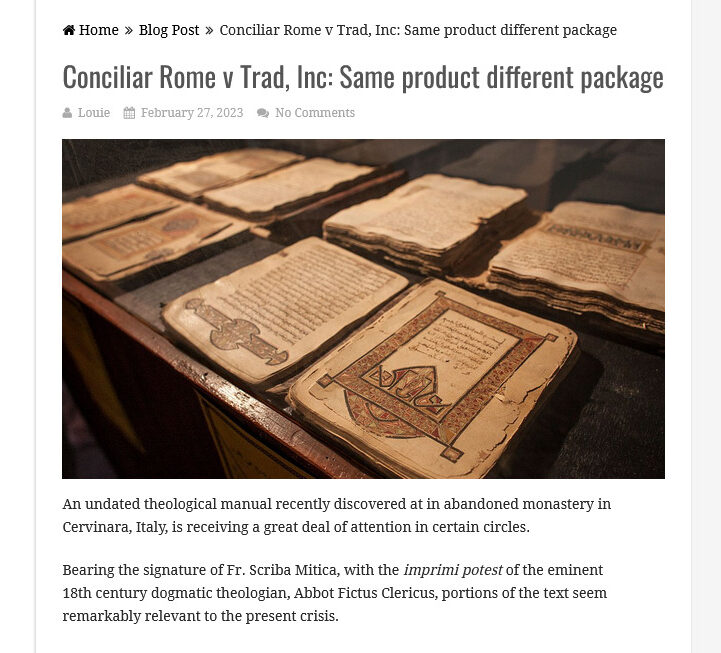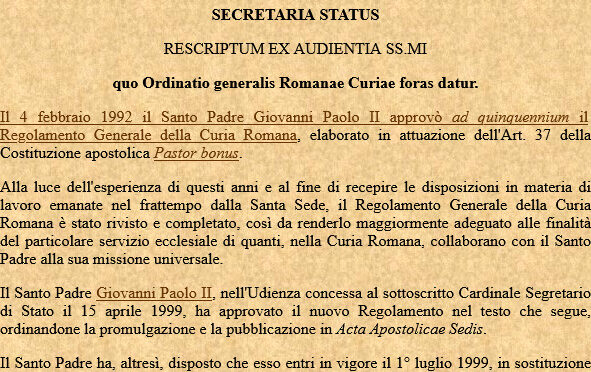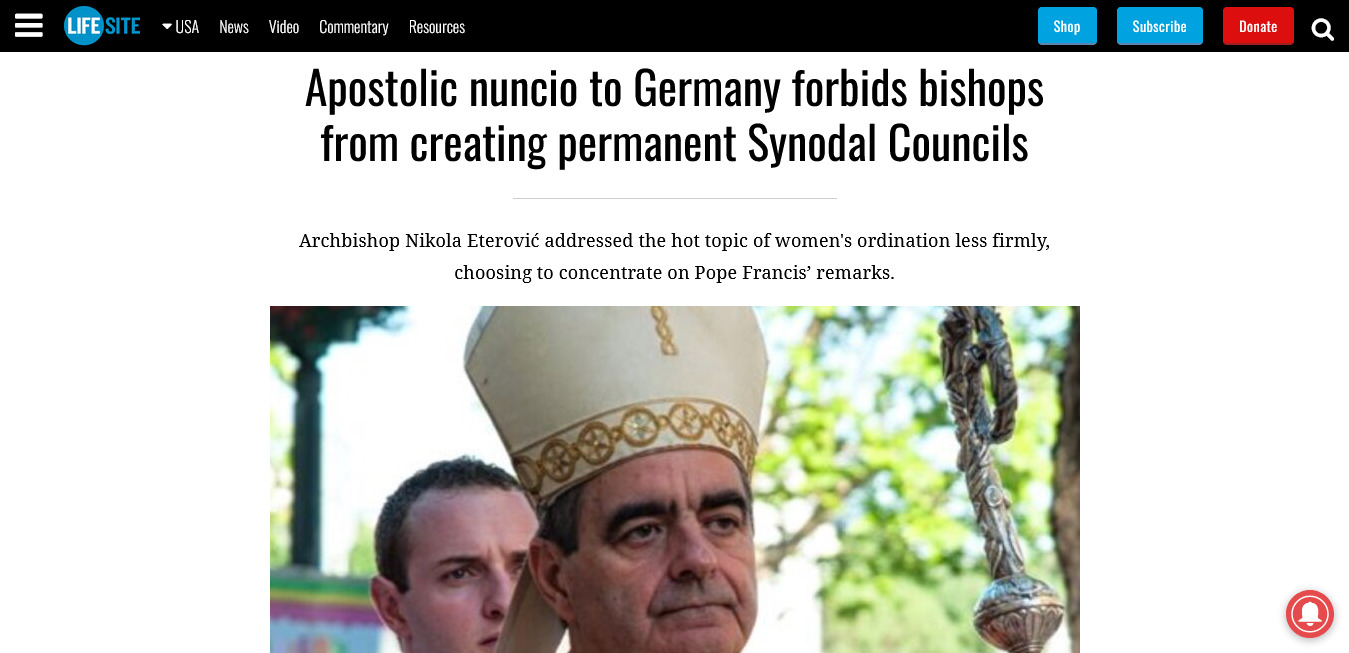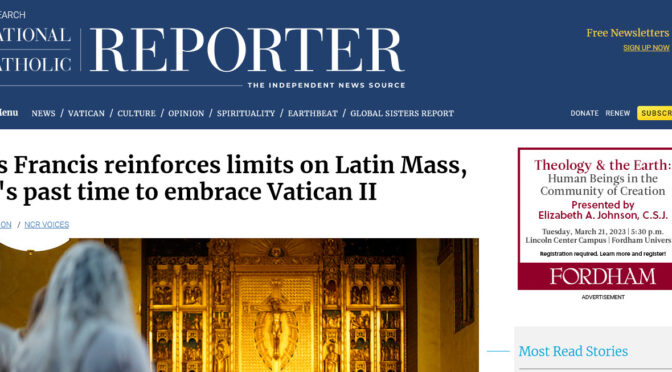Monthly Archives: March 2023
USA: The Greatest Spreader of Misinformation during the Scamdemic was the US govt.
Dowd: BigPharma is so corrupt, I would never take another of their products
Roche’s Document is not a Rescript, but a Rescriptum ex audentia Sanctissimi
by Br. Alexis Bugnolo
In the reactions to the recent declarations of Cardinal Roche, prefect of the Congregation for Divine Worship, we see once again, as in the events which followed the Declaratio of Pope Benedict XVI, that the MSM got it wrong from the start.
For the document published by Cardinal Roche is not a rescript, but a special administrative notice used only in the Roman Curia, called, a Rescriptum ex audentia Sanctissimi, or in English, A Rescript from an audience with the Holy Father.
As such, Rescripta ex audentia Sanctissimi have no legal value per se whatsoever, they are merely notices, or administrative declarations of the fact of an audience with the Holy Father.
When the Holy Father does approve a document with juridical effect, that is, which alters the status quo of some law or grants or removes the rights of others, the Rescriptum ex audentia Sanctissimi will include notice that on such and such a day, the new law will go into effect, the text of which is cited in the Rescriptum ex audientia Sanctissimi.
See the following case, as an example:
 When the Rescriptum ex audentia Sanctissimi lacks such information, it is clear that the Holy Father has decided nothing.
When the Rescriptum ex audentia Sanctissimi lacks such information, it is clear that the Holy Father has decided nothing.
Thus, if a Cardinal Prefect goes to the Holy Father and presents a box of chocolates for St. Valentines Day and informs him that his office has been redecorated, he can issue a Rescriptum ex audientia Sanctissimi, saying the Holy Father accepted the chocolates and approves of the redecoration from the photographs shown him on that occasion.
In other words, the Rescriptum ex audientia Sanctissimi has no inherent juridical value whatsoever, and is more an administrative act created by a subordinate who wants to document his meetings with the Holy Father and keep them as collectables.
The real question, therefore, becomes, not the juridical force of such documents, because they have none, but what is the authority of the Prefect of the Dicastery which publishes them.
And this is spelled out in the Regulations of the Roman Curia published by Pope John Paul II on July 1, 1999 A. D., a document which serves only to regulate the internal administrative process of those who serve the Holy Father at the Vatican. They key passages of which are articles 126, I, and II. I will include my own English translation of each section. The Vatican has never published their own.
From what follows, it can be clearly seen that Cardinal Roche has gone from his meeting with the Holy Father with no authority whatsoever to promote his unapproved agenda.
§ 1. Il Dicastero che ritiene opportuno chiedere al Sommo Pontefice l’approvazione in forma specifica di un suo atto amministrativo, deve farne richiesta per iscritto, adducendone i motivi e presentando il progetto di testo definitivo.
The Dicastery which judges it opportune to ask the Holy Father for his approval in forma specifica for one of it’s own administrative acts, must make its request in writing, adducing the motives and presenting the project in a definitive text.
Se l’atto contiene deroghe al diritto universale vigente, esse devono essere specificate ed illustrate.
If the act contains derogations from universal law currently in effect, these must be specified and explained.
§ 2. Analoga richiesta deve essere fatta qualora un Dicastero ritenga opportuno chiedere al Sommo Pontefice speciale mandato per seguire una procedura diversa da quella stabilita dal diritto.
An analogous request must be made whenever a Dicastery judges it opportune to ask the Holy Father for a special mandate to pursue a procedure diverse from that which has been established in law.
Anche in tal caso però le conclusioni non possono essere considerate approvate in forma specifica, a meno che siano poi sottoposte al Sommo Pontefice e da Lui approvate in tale forma.
Even in such a case, however, the conclusions cannot be considered approved in forma specifica, unless they have been submitted to the Holy Father and approved by Him in such a form.
§ 3. In ognuno dei detti casi il fascicolo relativo deve essere lasciato al Sommo Pontefice, in modo che Egli lo possa esaminare personalmente e comunicare in seguito la Sua decisione nel modo ritenuto opportuno.
In each of the said cases, the relative folder must be left with the Holy Father, so that He can examine personally its contents and communicate afterwards His decision in the manner judged opportune.
§ 4. Affinché consti dell’approvazione in forma specifica si dovrà dire esplicitamente che il Sommo Pontefice « in forma specifica approbavit ».
In order to be considered approved in forma specifica the text (of the Rescriptum ex audientia Sanctissimi) must explicitly say that the Holy Father has “approved it in forma specifica“.
Art. 126 bis [VI]
§ 1. Il Dicastero, che ritiene necessario richiedere al Sommo Pontefice speciali facoltà, deve farne domanda per iscritto tramite la Segreteria di Stato, allegando un progetto di testo definitivo, con l’indicazione precisa delle facoltà richieste, la motivazione della domanda e specificando le eventuali deroghe alle norme canoniche universali o particolari, che risulterebbero modificate o in qualche modo disattese.
The Dicastery, which judges it necessary to ask the Holy Father for a special faculty, must make the petition in writing by means of the Secretary of State, including with that the proposal of a definitive text, with precise indication of the faculties requested, the motivation for the petition and specifying the eventual derogations from universal or particular canonical norms, which would be modified or in any manner no longer observed.
§ 2. La Segreteria di Stato richiederà il parere dei Dicasteri competenti in materia e di quelli che ritenga eventualmente interessati, nonché del Pontificio Consiglio per i Testi legislativi per quanto attiene la corretta formulazione giuridica e, se fossero implicate questioni dottrinali, della Congregazione per la Dottrina della Fede.
The Secretary of State will ask the opinion of the competent Dicasteries in the manner and of those which he judges to be interested in the outcome, not omitting the Pontifical Council for Legislative Texts concerning what regards the correct juridical formulation and, if doctrinal matters be implicated, of the Congregation for the Doctrine of the Faith.
§ 3. Il fascicolo relativo alle facoltà speciali, che dovrà essere lasciato al Sommo Pontefice analogamente a quanto previsto nell’art. 126 § 3 del presente Regolamento, sarà composto dalla richiesta del Dicastero di cui al § 1, dai pareri ricevuti dai Dicasteri di cui al § 2, dall’eventuale riformulazione del progetto a cura del Dicastero richiedente, congiuntamente al Foglio d’Udienza a cura della Segreteria di Stato.
The folder relative to the special faculties, which must be left with the Holy Father similarly and as much as is foreseen in article 126 §3 of the present Regulations, will include the request made by the Dicastery as mentioned in n. 1, the opinions received from the Dicasteries mentioned in n. 2, and the eventual reformulation of the proposal as presented by the requesting Dicastery, in addition to the Foglio d’Udienza prepared by the Secretary of State.
§ 4. La Segreteria di Stato comunicherà ai Dicasteri della Curia Romana il testo delle facoltà eventualmente concesse dal Sommo Pontefice e, insieme al Dicastero richiedente, valuterà se e come procedere alla sua pubblicazione
The Secretary of State will communicate to the Dicasteries of the Roman Curia the text of the faculties eventually granted by the Holy Father and, together with that sent to the requesting Dicastery, will evaluate if and when to proceed to its publication.
Commentary
First, as canon 63 says, a rescript which includes a falsehood is invalid by the law itself. As a canon, this is a general principle which affects all rescripts, even those ex audientia sanctissimi.
In addition, since Traditionis Custodes was issued by one who did not have the munus petrinum at the time, it does not exist as a papal document, and therefore cannot be modified.
Thus, by authorizing a rescriptum ex audientia sanctisssimi, to modify the non existent law, rather than a new Apostolic Constitution, as Cardinal Roche wanted, Pope Francis did nothing juridical, and the resulting document is a dead letter on arrival. It is like authorizing the pruning of the rose buds on an apple tree. The authorization effects nothing, because the matter authorized does not exist in reality.
But even for those who are blind, as to the true and authentic value of Pope Benedict XVI’s Declaratio, the statement made in Roche’s rescriptum ex audientia sanctissimi, which states that 2 things are to require dispensation reserved to the Holy See, refers to canon 87 §1, but misapplies this to Traditionis Custodes 3 §2, and 4, which is a general grant, not a procedural law, and thus, returns the same, a totally invalid and in-efficacious decision — and one obviously made in violation to the regulations above translated, which require an intervention of the Pontifical Council for Legislative Texts, in cases of the modification of a universal law, which Council would have pointed out the erroneous ordinance.
In fact, by not having the matter referred to the Pontifical Council, it is clear that Pope Francis has acted on the basis of considering Traditionis Custodes as NOT a universal law, which is it not.
But if one were to insist, then the changes mean that if a bishop wants to act otherwise than in nn. 3 and 4, he needs to obtain a dispensation from the Holy See. But that is a rare case and definitely does not mean that masses should be suppressed or ordinations cancelled.
While I got it wrong in calling this document a simple rescript, on Feb. 20, the results remain the same, however. This document is not one to lament over, rather, it is one to laugh about.
Thus, Christ Jesus, Who as God and Creator, is by nature a Legislator, has intervened twice in this matter to protect the rights of His faithful to use the ancient rites inspired and protected by His Holy Spirit throughout the ages, and by His true vicars on earth. And we should loudly proclaim this to the glory of God His Father.
And for those who do not follow canon law, as true catholics should, we have another and even stronger example to confound them: because if you do not recognize that Pope Benedict XVI never abdicated AND that Pope Francis was validly elected on Jan. 30, 2023, then there is no way to explain what just happened.
New Fusion Process promises Clean Power
Editor’s Note: While the Wefers have been planning and insisting on a carbon free world as a mere excuse to enslave humanity and establish a fuedalistic society in which only some have access to electricity and transportation, real scientists have been working on the next great leap forward in the production of electrical power: fusion generation. Unlike fission which splits atoms and creates radioactive particles, fusion joins atoms together as the Sun does naturally, to create tremendous quantities of heat and power. The problems of fusion power production have been under study in the last 40 years, and this new team appears to have solved them in a way that is commercially viable for the first time.
VATICAN: Pope has Nuncio to Germany forbid permanent Synodal Councils
Saint Vincent Seminary remembers Msgr. Gracida
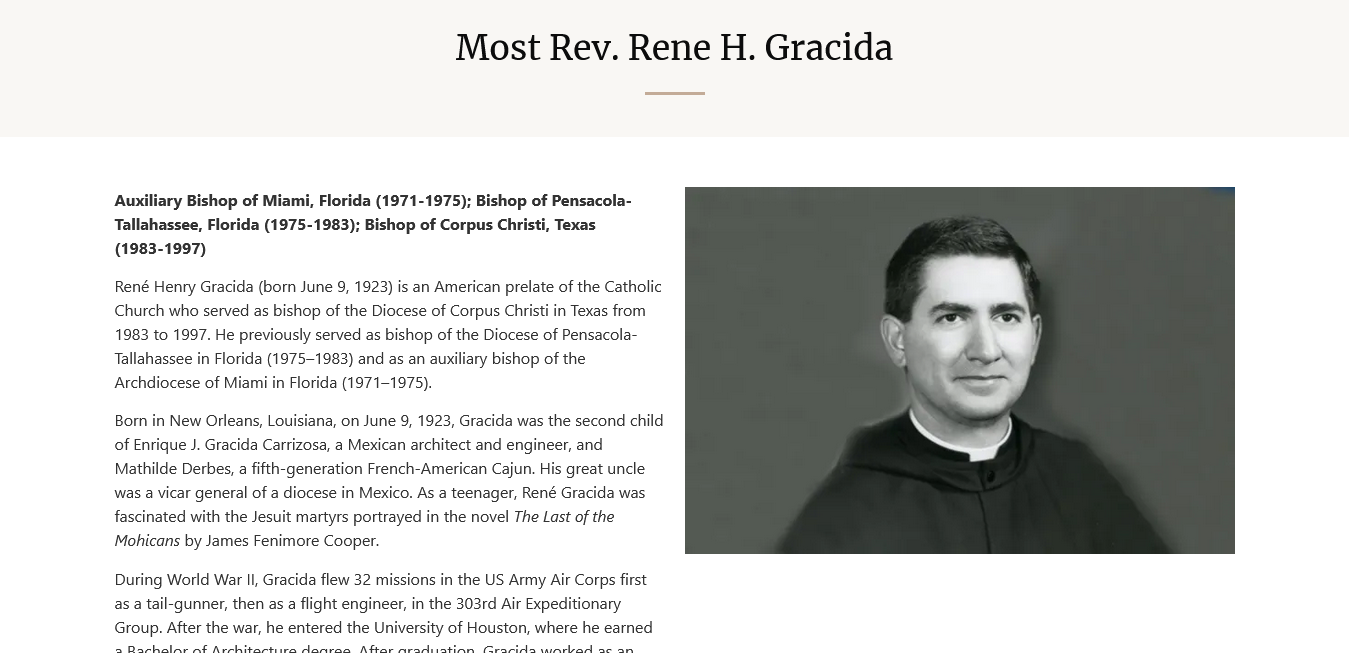 Here is a short biography of the currently 2nd oldest Bishop in the Catholic Church. This biography was updated on Feb. 16, 2023 A. D., which shows in what great respect, Bishop Gracida is still held at his alma mater, Saint Vincent’s Seminary, Latrobe, Pennsylvania.
Here is a short biography of the currently 2nd oldest Bishop in the Catholic Church. This biography was updated on Feb. 16, 2023 A. D., which shows in what great respect, Bishop Gracida is still held at his alma mater, Saint Vincent’s Seminary, Latrobe, Pennsylvania.
Here is a PDF from the time of the Episcopal Consecration of Msgr. Gracida: the January 28, 1972 edition of The Voice:
A debate on traditionalist blogs about the Episcopal Consecration of this Bishop erupted in 2022. You can see such, here. You can find the texts from the previous pontifical here. And yes, I am a “Historian”. It is important to note, that on p. 8A of the PDF, it states clearly that at the time of his consecration, Father Gracida was rector of the Cathedral, even though the official website of the Cathedral today omits this fact, in a snub to Bishop Gracida. I wrote to the Cathedral to ask them to correct that nearly two weeks ago, but they have not yet acted.
An Exposé of Vladimir Putin, seducer of the Russian People
The anti-Church is an alternate Church with an alternate canonical reality
by Br. Alexis Bugnolo
For more than 10 years we have been fed with an alternate reality from a group of Catholics who want an alternate Church. And it has been very difficulty for many Catholics, who discern truth, not on the basis of objective criteria, but on the basis of the majority of bits of information they receive, to discern who is right and who is wrong.
It’s like a classroom in a public school run by radical cultural marxists, where, in the class on Mathematics, when the teacher writes 2+3 = ?, she does not tell the class the answer, or ask them to calculate the correct answer, but instead says, “Let’s take a poll: who thinks the answer is 4, and who thinks the answer is 6?” To determine the truth of the question.
The only problem is, in such a chaotic classroom, the true answer is not allowed to be uttered. Everyone must live in the alternate reality and follow the alternate mathematics.
This is the ultimate phase of the dictatorship of relativism condemned by Pope Benedict XVI. And you cannot claim to be a true Catholic if you refuse to avoid this error.
But to avoid the dictatorship of relativism, you have to do something truly radical, rational, and traditional: you have to return to the ancient definition of truth, “which is the conformity of the mind with reality,” not with what others want that reality to appear to be.
This is why social media, and indeed all electronic media, are very unreliable sources of information to make true decisions, simply because there is too great a capacity granted to those who control the media and the content to claim that the reality is other than it is. And this is social media’s most potent power to control you: disinformation.
A case example of the Alternate Church with its Alternate Canonical reality
To help one understand this better, let’s take a look at a real case: the claim being made by Cardinal Roche, Prefect of the Congregation of Divine Worship and the Sacraments, regarding the canonical value of his personal agenda of talking points, which he is now claiming is a rescript.
Here, I will cite for your the editorial on this topic by Michael Sean Winters, in the National Catholic Reporter, one of the most left-wing publications in the United States, which voices neither national opinions, not Catholic beliefs, nor presents reporting, other than planned propagandistic talking points of Freemasonry.
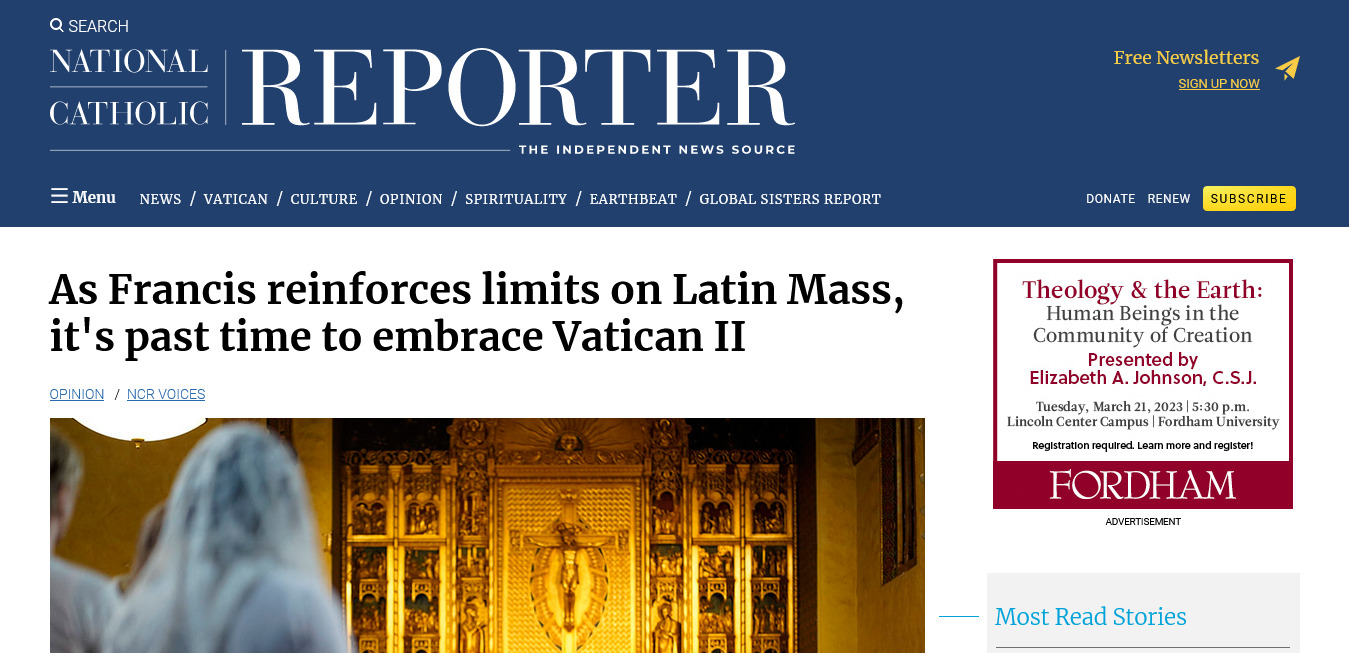 What is most striking about his editorial is that on the principle points of the facts he claims exist, he is in perfect agreement with all the Traditionalist social media influencers.
What is most striking about his editorial is that on the principle points of the facts he claims exist, he is in perfect agreement with all the Traditionalist social media influencers.
How can that be?
Well apart from objective facts, that is, the claims made by Cardinal Roche, they are both reading from the same alternate Canon Law, and thus are in agreement with the notions of the alternate Church.
Let’s examine these one by one, to see on what basis this alternate Church is claimed to exist and what are its fundamental doctrines, so that we can understand why on earth it is, that Traditionalist social media influencers are on-board, when they should be doing the exact opposite.
The Pope is not whom Canon Law says is pope, but rather is he whom the MSM says is pope
We have seen this already for 10 years. It has to do with the Declaratio of Pope Benedict XVI on Feb. 11, 2013. According to the norm of Canon Law, it was an administrative decision based on the authority granted the person who is the pope in Canon 333 §2, whereby he is free to exercise the Petrine Ministry in any way he thinks best. But it was announced to the world, rather, as an act of Canon 332 §2, whereby the man who is the pope renounces the Papacy and abdicates.
This is where the true Church of Christ separates from the alternate Church. Here at FromRome.Info, we have by study, analysis and investigation shown how this error was propagated and just what it means (here and here).
As regards the present claims of Cardinal Roche, who was appointed by Pope Benedict XVI to head the Congregation for Divine Worship, the true canonical reality has immediate effects. The first of which is that he was not the head of the Congregation of Divine Worship from Feb. 28, 2013, when Pope Benedict XVI renounces his ministry and effectively suspended all canonical functions of the entire Roman Curia, until January 30, 2023, when the faithful of the Church of Rome elected Jorge Mario Bergoglio as pope. Thus, Cardinal Roche has no authority to make any reference to any meeting he had with Pope Francis prior to Jan. 30th. And since his “rescript” claims that, it is ipso facto invalid in virtue of canon 63 §2, which declares all rescripts to have no force of law if they contain a falsehood.
The same results by Cardinal Roche’s reference to Traditionis Custodes, which is a non existent document. I say, “non-existent” in the canonical sense, since Jorge Mario Bergoglio had no authority to issue it since at that time he did not hold the petrine munus, which Pope Benedict XVI never renounced in life.
The Church must conform Herself to the Masonic Agenda, not to Tradition
Returning to the article in the NCR, it is patently absurd that the Cardinal claims that two world wars necessitated Church reform, especially of the liturgy. This is some sort of Masonic dribble, because the Church has had the same liturgy throughout 2000 years of wars and the most tremendous cultural and economic changes, world wide. What the Cardinal seems to be saying, rather, is that the stunning success of the Pilgrim Society to destroy Christendom in Europe must now be followed up by the total eradication of the traditions of Catholic worship in the Church.
This is an alternate view of reality for an alternate Church.
Obedience must be shown to non-existent documents made more restrictive by non-existent rescripts
And thus, Winters in his editorial accuses the Bishops in the United States of arrogating the right to ignore the non-existent document of a non-pope. Here we find ourselves in the analogous position of a mental asylum arguing with a patient who claims to be Napoleon Bonaparte, and who insists that the Napoleonic Code is not being observed by the janitor in the cleaning of the toilets with the brush in the right hand rather than in the left, as he himself decreed just last week!
I have already mentioned, here, that it is not even a question of understanding the rescript as invalid in virtue of canon 63, as I stated above, since a rescript by its very nature is a favor granted by a superior, not a juridical act whereby a non-existent law is made more restrictive by an inferior who claims his superior approved his self-signed crib-notes for the meeting.
We are in full-blow alternate reality here.
Juridical acts of the Roman Pontiff are issued only by the Roman Pontiff, in written form, signed by 2 bishop witnesses. No mere curial official can take away the canonical rights of anyone, not even by whim or fraud.
Yet the traditionalist social media influences don’t even suspect the alternate reality as alternate. For them, as well as the leftist NCR, their alternate is the only reality. And. Don’t. You. Dare. Claim. Otherwise.
They are like the other patient at the asylum, who claims to be Josephine, the wife of Napoleon, and who barks in unison with him, in all his madness.
Christ, however, by His High Priestly prayer for Pope Francis, has protected the rights of all Catholics who recognize the traditional Roman Rite as the only one inspired by God, by preventing Pope Francis as pope, from affirming in any way either the non-existent Traditionis Custodes, or the demands of Cardinal Roche, dismissing him with the embarrassing situation of having to make claims on his own authority, and sending a strong message to all true Catholics, who live in the true Church with the true Canon Law, that the Traditional Rites remain forever free and accessible to all.
UPDATE:
Here Mr. Lamb appears to have read FromRome.Info from the other side of the fence.

